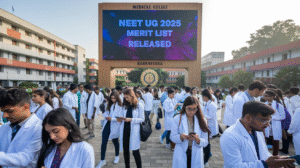Are you dreaming of becoming a doctor but dreading the NEET exam? 🩺📚 We understand the pressure and uncertainty that comes with pursuing an MBBS degree in India. The National Eligibility cum Entrance Test (NEET) has become the ultimate gatekeeper for medical aspirants, leaving many wondering: Is it possible to get MBBS admission without an entrance exam?
We’ve got good news and bad news. The truth is, NEET is mandatory for MBBS admissions in India, with no exceptions. But don’t lose hope just yet! There are alternative pathways to fulfill your medical dreams. From exploring MBBS options abroad to considering allied health sciences, we’ll guide you through the maze of medical education possibilities. 🌍🎓
In this blog post, we’ll dive deep into the world of MBBS admissions, uncovering everything from understanding NEET and its importance to navigating the admission process and preparing for success. We’ll also explore financial aspects and international options that might surprise you. So, whether you’re determined to crack NEET or looking for alternatives, stick with us as we unravel the complexities of pursuing your medical aspirations!
Understanding NEET: The Gateway to MBBS in India

A. Overview of NEET (National Eligibility cum Entrance Test)
The National Eligibility cum Entrance Test (NEET) is a standardized assessment administered by the National Testing Agency (NTA) for admission to undergraduate medical programs across India. We understand that NEET serves as the primary gateway for aspiring medical students, evaluating candidates for various disciplines including:
- Bachelor of Medicine and Bachelor of Surgery (MBBS)
- Bachelor of Ayurvedic Medicine and Surgery (BAMS)
- Bachelor of Unani Medicine and Surgery (BUMS)
- Bachelor of Siddha Medicine and Surgery (BSMS)
- Bachelor of Homeopathic Medicine and Surgery (BHMS)
As established by the Ministry of Education, the NTA ensures an efficient and transparent testing process aligned with international standards. This uniform entrance test complies with respective legislative acts governing these medical fields, making it a crucial step for students aiming to pursue a career in medicine.
B. Exam structure and scoring system
While the reference content doesn’t provide specific details about the exam structure and scoring system, we can infer that NEET is designed to assess candidates’ knowledge and aptitude for medical studies. The NTA, responsible for conducting the exam, focuses on maintaining high standards and fairness in the evaluation process.
C. Eligibility criteria and age requirements
Although the provided reference content doesn’t explicitly mention age requirements, it does highlight some key points regarding eligibility:
- The NTA addresses concerns about examination eligibility for voters, indicating that there may be age-related criteria for NEET candidates.
- The registration window for NEET allows candidates to correct application details, suggesting that meeting specific eligibility criteria is crucial for participation.
D. Importance of NEET for medical admissions
We cannot overstate the significance of NEET in the medical admission process in India. Here’s why it’s so important:
- Standardized Assessment: NEET provides a uniform evaluation method for all aspiring medical students across the country.
- Multiple Disciplines: It serves as the entrance test for various medical fields, including allopathy, ayurveda, unani, siddha, and homeopathy.
- Nationwide Acceptance: NEET results are recognized by premier medical institutions throughout India.
- Transparency: The NTA’s involvement ensures a fair and transparent admission process.
- Multiple Languages: NEET is conducted in multiple languages, making it accessible to a diverse range of candidates.
To illustrate the scope of NEET, let’s look at a comparison of the medical disciplines it covers:
| Discipline | Full Form | Degree |
|---|---|---|
| Allopathy | Modern Medicine | MBBS |
| Ayurveda | Traditional Indian Medicine | BAMS |
| Unani | Greco-Arabic Medicine | BUMS |
| Siddha | Traditional Tamil Medicine | BSMS |
| Homeopathy | Alternative Medicine | BHMS |
It’s worth noting that the NTA continuously updates and improves the NEET process. Recent developments include:
- Release of re-revised score cards and final answer keys
- Publication of city-wise results
- Revised rankings for all candidates
- Reconduct of exams for affected candidates
- Addressing concerns about impersonation
With this comprehensive understanding of NEET as the gateway to MBBS in India, we’ll now explore the various MBBS admission pathways in the next section. We’ll delve into the different routes available for aspiring medical students, both within India and abroad, to help you make informed decisions about your medical education journey.
Exploring MBBS Admission Pathways

Now that we’ve explored the importance of NEET as the primary gateway to MBBS in India, let’s delve into the various MBBS admission pathways available to aspiring medical students.
A. Government colleges and prestigious institutions
Government colleges and prestigious institutions in India remain the most sought-after options for MBBS education. These institutions typically require NEET scores for admission, emphasizing the exam’s significance in the medical education landscape. While we focus on alternatives, it’s important to note that NEET continues to be the primary route for entering top-tier medical schools in India.
B. Private universities and their admission processes
Private universities offer another pathway for MBBS aspirants. While many private institutions in India also require NEET scores, some have developed alternative admission processes. These may include:
- Entrance exams specific to the university
- Merit-based admissions considering school marks
- Interviews and aptitude tests
It’s crucial to research and verify the accreditation status of private universities to ensure the validity of their MBBS programs.
C. Management quota and NRI seats
Some private medical colleges in India offer seats under management quota and NRI (Non-Resident Indian) categories. These options may provide an alternative route for MBBS admission:
| Quota Type | Key Features |
|---|---|
| Management Quota | – Higher fees than regular seats<br>- May have relaxed entrance criteria<br>- Limited number of seats available |
| NRI Seats | – Reserved for Non-Resident Indians or their dependents<br>- Higher fees in foreign currency<br>- May have separate admission process |
While these pathways might seem appealing, we must emphasize that they often come with significantly higher costs compared to merit-based admissions.
D. Alternative medical courses without NEET
For those seeking medical education without NEET, there are alternative courses worth considering:
- AYUSH (Ayurveda, Yoga and Naturopathy, Unani, Siddha, and Homeopathy) programs
- Allied health sciences courses
- Paramedical courses
- Nursing programs
These alternatives offer opportunities in the healthcare sector without the need for NEET scores. However, it’s important to note that these courses lead to different career paths compared to MBBS.
We must also mention that some international universities offer MBBS programs that don’t require NEET scores. Countries like Russia, China, the Philippines, Georgia, and Kazakhstan have become popular destinations for Indian students seeking MBBS education abroad.
Key considerations for international MBBS programs include:
- Eligibility criteria (typically 50% marks in Physics, Chemistry, and Biology)
- English proficiency requirements (IELTS or TOEFL)
- Recognition of the degree in India and globally
- Financial aspects (tuition fees and living expenses)
- Licensing exams upon return to India (FMGE/NEXT)
While these international options provide an alternative to NEET-based admissions, they come with their own set of challenges and requirements. Students must carefully weigh the pros and cons, considering factors such as quality of education, cultural adaptation, and future career prospects.
With this understanding of various MBBS admission pathways, we’ll next explore the specifics of pursuing MBBS abroad without NEET, providing a deeper insight into this increasingly popular option for Indian medical aspirants.
MBBS Abroad: Options Without NEET

Now that we’ve explored various MBBS admission pathways, let’s dive into the options available for studying MBBS abroad without NEET. This alternative route can be particularly appealing for those seeking international exposure and different educational experiences.
A. Countries offering NEET-free admissions
We’ve identified several countries that offer MBBS programs without requiring NEET scores. Here’s a list of some popular destinations:
- Russia
- Canada
- Germany
- Georgia
- Bangladesh
- Philippines
- United Kingdom
- United States
- China
- Italy
- Australia
- Nepal
- Kyrgyzstan
- Uzbekistan
Among these, Russia stands out as a particularly popular choice. We’ve found that Russian medical programs are known for their affordability, global recognition, and comprehensive six-year curriculum that includes an internship.
B. Application process for international medical programs
When applying for MBBS programs abroad without NEET, we need to follow these general steps:
- Research universities in the chosen country
- Check eligibility criteria
- Gather necessary documents
- Submit applications along with required fees
The eligibility criteria typically include:
- Being at least 17 years old
- Completing 10+2 with a minimum of 50% in Physics, Chemistry, and Biology
- Possessing a valid passport and visa
- Demonstrating English proficiency through standardized tests
- Obtaining an eligibility certificate from the Medical Council of India (MCI)
Required documents usually comprise:
- Academic transcripts
- English test scores
- Proof of funds
- Additional paperwork specific to the chosen country
C. Budget-friendly options for studying MBBS abroad
We’ve compiled a comparison of some affordable MBBS destinations:
| Country | Advantages | Approximate Annual Fees (USD) |
|---|---|---|
| Russia | Affordable, globally recognized, English-taught | 3,000 – 5,000 |
| Uzbekistan | English-medium programs, competitive fees | 4,000 – 6,000 |
| China | English-taught programs, modern facilities | 5,000 – 8,000 |
| Philippines | English-medium instruction, tropical climate | 3,500 – 6,000 |
| Ukraine | Affordable, English-taught programs | 3,500 – 5,500 |
D. Considerations for practicing in India after foreign MBBS
We must emphasize that studying MBBS abroad without NEET comes with certain limitations for those planning to practice in India:
- Candidates who haven’t qualified NEET are not permitted to practice medicine in India.
- Internships completed abroad are not recognized in India.
- To practice in India after foreign MBBS, compliance with MCI regulations is mandatory.
- Passing the Foreign Medical Graduate Exam (FMGE) is essential for Indian practice.
Given these considerations, we strongly encourage students to reconsider taking the NEET exam before opting for international studies if their goal is to practice in India.
With this understanding of MBBS options abroad, we’ll next navigate the MBBS admission process in more detail, providing you with valuable insights to make informed decisions about your medical education journey.
Navigating the MBBS Admission Process

Now that we’ve explored MBBS options abroad without NEET, let’s delve into the intricacies of navigating the MBBS admission process in India. While pursuing MBBS abroad may offer alternatives to entrance exams, the domestic route typically involves a structured admission process centered around NEET.
Steps from NEET to securing a seat
We begin our journey with the National Eligibility cum Entrance Test (NEET-UG), which serves as the gateway to MBBS admissions in India. Here’s a breakdown of the process:
- NEET-UG Examination: Scheduled for May 4, 2025
- Result Declaration: Candidates must meet the cutoff scores (50th percentile for general, 40th for reserved categories)
- Counselling Registration: Register on the Medical Counselling Committee (MCC) portal
- Document Verification: Submit required documents for verification
- Seat Allocation: Based on preferences, rank, and availability
- Fee Payment: Secure the allocated seat by paying the required fees
Required documents for admission
We must ensure we have all necessary documents ready for a smooth admission process. Here’s a checklist:
- NEET admit card
- NEET scorecard
- Class 10 certificate
- Class 12 certificate
- Valid ID proof
- Other relevant certificates (category, domicile, etc.)
Counseling rounds and seat allocation
The counseling process is crucial in securing an MBBS seat. We’ll walk you through the different rounds:
Round 1
- Registration and choice filling
- Seat allotment based on merit and preferences
- Reporting to the allotted institution
Round 2
- For candidates who didn’t secure a seat in Round 1
- Fresh registration and choice filling
- Seat allotment and reporting
Round 3 (if applicable)
- Similar process to previous rounds
- Aims to fill remaining vacant seats
MOP-UP round for filling remaining seats
After the main counseling rounds, a MOP-UP round is conducted to fill any remaining seats. This round provides an additional opportunity for candidates who haven’t secured a seat in previous rounds.
| Aspect | MCC Counselling | State Counselling |
|---|---|---|
| Seats Covered | 15% All India Quota, Deemed Universities | 85% State Quota |
| Eligibility | All India NEET rank | State NEET rank |
| Conducting Authority | Medical Counselling Committee | State Authorities |
We must note that the admission landscape for MBBS in India is highly competitive. With over 1 lakh MBBS seats available across more than 600 medical colleges, including prestigious institutions like AIIMS and JIPMER, securing a seat requires strategic planning and informed decision-making.
For those with lower NEET scores, we still have options. Some alternatives include:
- State counselling
- Management quotas in private colleges
- NRI quotas in private institutions
However, these options often come with higher fees and intense competition.
With this comprehensive understanding of the MBBS admission process, we’re now better equipped to navigate this challenging journey. Next, we’ll focus on preparing for NEET success, which is crucial for maximizing our chances of securing a seat in our desired medical college.
Preparing for NEET Success

Now that we’ve navigated the MBBS admission process, let’s focus on preparing for NEET success, which is crucial for those seeking admission through the traditional entrance exam route.
A. Syllabus overview and subject weightage
The NEET syllabus aligns with the NCERT curriculum for Classes 11 and 12, covering Physics, Chemistry, and Biology (Botany and Zoology). Here’s a breakdown of the exam pattern and subject weightage:
| Subject | Number of Questions | Marks |
|---|---|---|
| Physics | 45 | 180 |
| Chemistry | 45 | 180 |
| Biology (Botany & Zoology) | 90 | 360 |
| Total | 180 (out of 200) | 720 |
It’s essential to note that while 200 questions are presented, only 180 need to be attempted. The marking scheme awards +4 for correct answers and deducts -1 for incorrect ones, emphasizing the importance of accuracy.
B. Effective study strategies and time management
We recommend adopting the following strategies for effective NEET preparation:
- Start early and set achievable targets
- Reinforce basic concepts before progressing to complex topics
- Create a personalized timetable with dedicated study blocks for each subject
- Focus on NCERT textbooks as the primary resource
- Utilize supplementary materials for challenging areas
- Maintain a balance between study and relaxation
Time management is crucial. We suggest allocating specific time slots for each subject and incorporating regular revision periods. A structured study routine enhances learning efficiency and helps maintain consistency in preparation.
C. Importance of practice tests and past papers
Practice tests and past papers play a vital role in NEET preparation. We emphasize their importance for several reasons:
- Familiarize with exam format and question types
- Enhance time management skills
- Identify strengths and weaknesses
- Improve problem-solving abilities
We recommend participating in test series that prioritize quality over quantity. Additionally, practicing past years’ questions is essential for grasping exam patterns and types of questions frequently asked.
D. Tie-breaking policies and updated exam format
For NEET 2025, it’s crucial to be aware of the latest exam format and tie-breaking policies. While specific details for 2025 may not be available yet, we can provide insights based on recent trends:
- The exam typically consists of 200 multiple-choice questions
- Time allotted is usually 3 hours (180 minutes)
- Sections are often presented in the order of Biology, Chemistry, and Physics
In case of tie-breaking, factors such as:
- Higher marks in Biology
- Higher marks in Chemistry
- Number of correct responses in Biology
- Number of correct responses in Chemistry
May be considered, though the exact policy may vary.
We advise tackling the exam sections in the suggested order to build confidence and manage time effectively. Additionally, marking difficult questions for later review and maintaining organized rough work can help avoid mistakes and maximize scores.
As we conclude our discussion on preparing for NEET success, it’s important to remember that while thorough preparation is crucial, financial considerations also play a significant role in pursuing an MBBS education. In the next section, we’ll explore the financial aspects of MBBS education, providing you with a comprehensive understanding of the investment required for this prestigious career path.
Financial Aspects of MBBS Education

Now that we’ve explored how to prepare for NEET success, let’s delve into an equally important aspect of pursuing an MBBS degree: the financial considerations. Understanding the costs involved and the available financial assistance options is crucial for aspiring medical students.
Fee structures in government vs. private colleges
We’ve observed significant variations in MBBS course fees across different types of institutions in India. Here’s a breakdown of the fee structures:
| Institution Type | Annual Tuition Fee Range (INR) |
|---|---|
| Government | 5,700 – 54,900 |
| Central Universities | 1,10,000 – 2,15,000 |
| Deemed Universities | 5,00,000 – 25,00,000 |
| Private Colleges | 4,00,000 – 17,95,000 |
It’s important to note that government colleges generally offer more affordable options. For instance, prestigious institutions like AIIMS Delhi and PGIMER Chandigarh charge annual tuition fees of INR 23,300 and INR 28,000, respectively. In contrast, private colleges and deemed universities can charge significantly higher fees, especially for management and NRI quota seats.
Scholarships and financial aid options
We understand that the high costs of medical education can be daunting. Fortunately, there are various scholarship opportunities available for aspiring medical students in India. Some notable options include:
- Bharati Scheme
- Vahani Scholarship
These scholarships can provide financial support ranging from INR 20,000 to full tuition coverage. We encourage students to thoroughly research and apply for these opportunities to ease their financial burden.
Cost considerations for MBBS abroad
While we’re primarily focusing on MBBS education in India, it’s worth noting that studying abroad can be a considerably more expensive option. For instance, NRI quota fees in deemed universities can range from $25,000 to $220,000 per year. We advise students considering this path to carefully weigh the costs against the potential benefits and career prospects.
Return on investment: Career prospects and salaries
When considering the substantial investment in an MBBS education, we must also look at the potential returns. While specific salary information isn’t provided in our reference content, we can infer that the career prospects for MBBS graduates are generally positive. The high demand for healthcare professionals and the prestige associated with the medical profession often translate to good career opportunities and potential for growth.
We’ve seen that government medical education tends to be more affordable compared to private institutions. However, we must consider factors beyond just the tuition fees. Additional costs such as hostel fees, books, and living expenses can significantly impact the overall financial burden.
In conclusion, we’ve explored the various financial aspects of pursuing an MBBS degree. From the stark differences in fee structures between government and private institutions to the availability of scholarships and the potential return on investment, it’s clear that careful financial planning is crucial for aspiring medical students. We encourage prospective students to thoroughly research their options, consider their financial capabilities, and make informed decisions about their medical education journey.

Throughout this blog post, we’ve explored the various aspects of MBBS admissions, focusing on the possibility of securing a seat without an entrance exam. We’ve delved into the significance of NEET as the primary gateway for medical education in India, examined alternative pathways for MBBS admissions, and discussed options for studying medicine abroad.
While NEET remains the mandatory entrance exam for MBBS programs in India, we’ve highlighted several alternatives for aspiring medical students. These include pursuing MBBS abroad in countries that don’t require NEET, considering allied health sciences courses, or exploring other medical programs. We’ve also touched upon the financial aspects of medical education and the importance of thorough preparation for those opting to take the NEET exam. As the landscape of medical education continues to evolve, we encourage prospective students to stay informed about the latest developments and explore all available options to achieve their dream of becoming a doctor.
💬 Instant WhatsApp Support
Get real-time assistance for urgent queries about applications & deadlines
Average response time: 15 minutes
📞 One-on-One Consultation
Speak directly with our senior admission counselors for comprehensive guidance
Available Mon-Sat: 9 AM - 7 PM IST
Sunday: 10 AM - 4 PM IST
📩 Detailed Inquiry Form
Share your details and our experts will craft a personalized admission strategy






